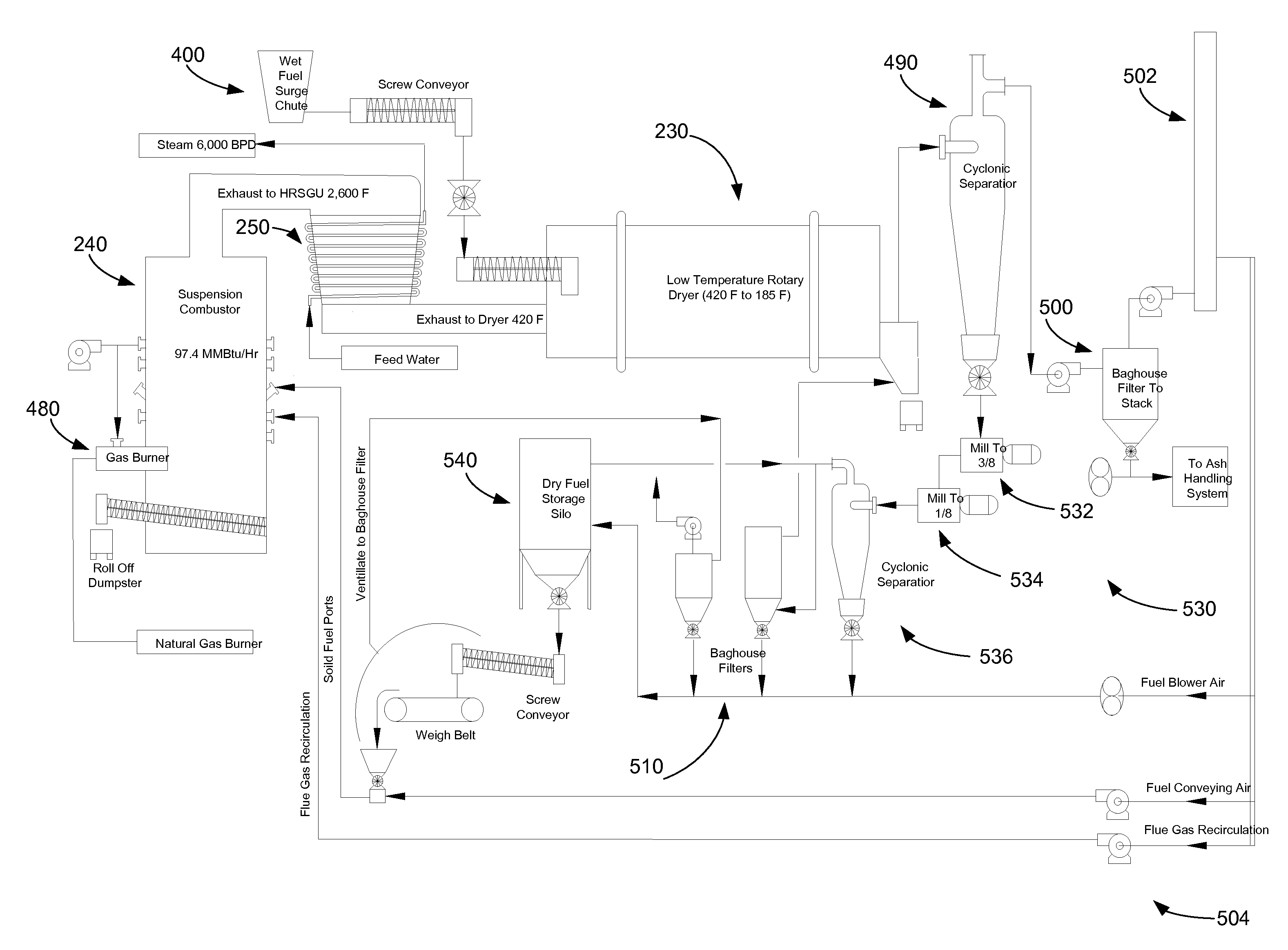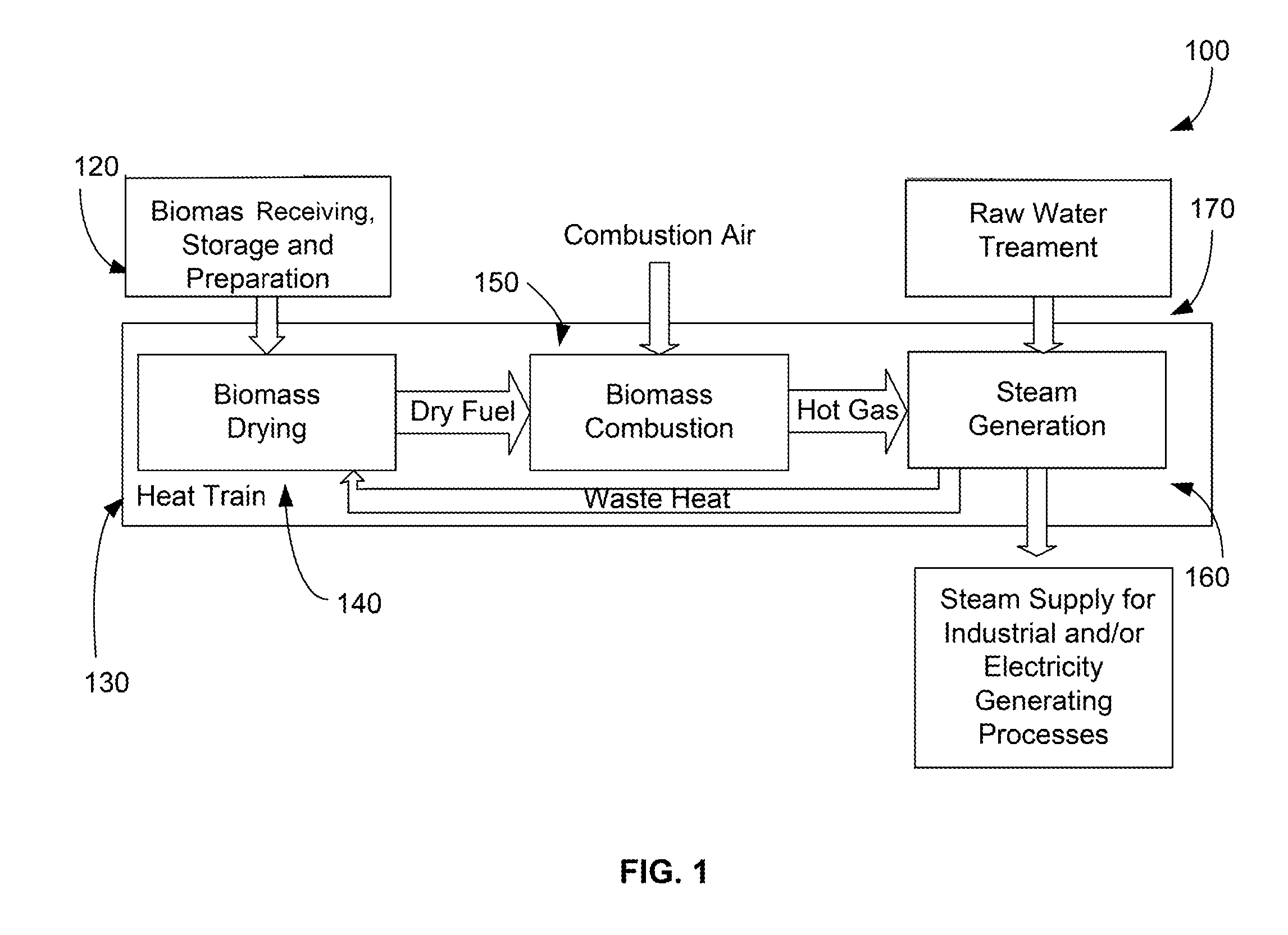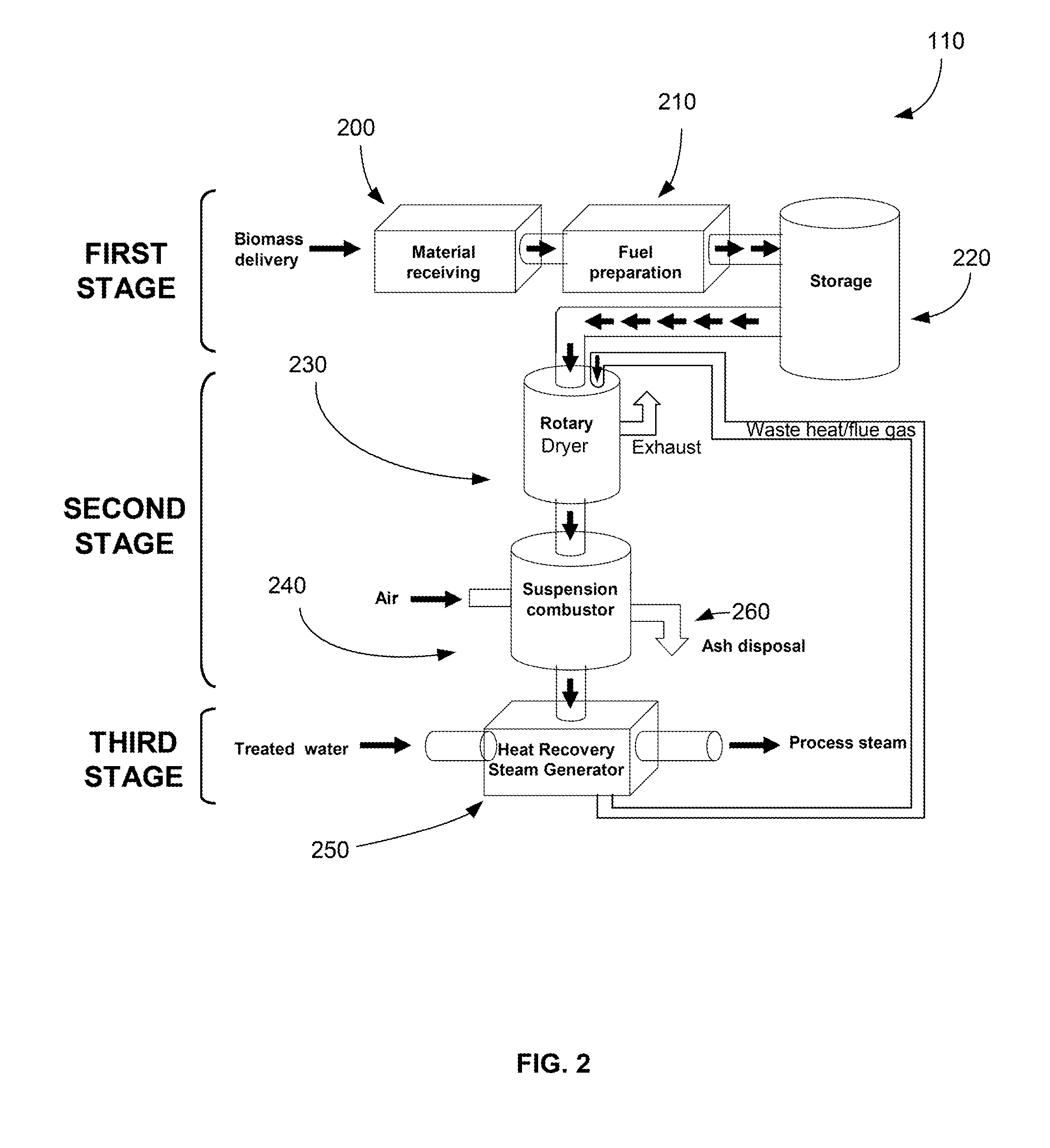With increasing restrictions on open burning, increasing landfill costs and decreasing availability of landfill and other disposal options, the cost of
waste management has increased dramatically across multiple industries during recent years and is expected to increase further.
This is a particularly serious problem for those, such as agricultural producers, wood and pulp products producers, municipalities, and
electric utility companies, who have large quantities of waste wood and / or diverse biomass for disposal.
Such methods are effective to produce energy from waste wood but tend to be difficult to control because of the size and
moisture content of the particles and variations in size,
moisture, type, and quality.
Making these traditional methods even marginally acceptable from an air emissions standpoint requires the addition of expensive chemical additive-based
pollution control equipment, particularly for
NOx.
The
air emission and
thermal efficiency difficulties associated with traditional wood to energy conversion are only compounded when more diverse types of biomass waste such as manures,
crop residue, and
green waste, are used as fuel.
NOx emissions are a concern because they contribute to the formation of
acid rain and, either directly or through the creation of
ozone, lead to harmful effects on
human health.
Due to a number of other technical challenges, SCR applied to biomass is arguably not feasible at this time.
It leaks less
ammonia, but is not as effective at removing
NOx.
SNCR still adds considerable capital and
operating cost to the project, certainly at least on the order of millions of dollars per year.
Many plants employing current combustion methods are proving unable to meet these levels, and proposed new rules will even be tighter.
These suspension furnaces, which include tangentially-fired suspension furnaces and wall-fired suspension furnaces, are still used to some extent by utilities and manufacturing companies such as paper mills, but are relatively inefficient when compared to furnaces or boilers that burn fossil fuels.
Moreover, particulate fuel suspension furnaces typically produce higher levels of
air pollutants than modern waste wood or
fossil fuel reactors.
Attempts have been made to more economically produce energy with suspension furnaces by burning wood in such furnaces along with fossil fuels, but those attempts have not been successful in replacing over 50% by weight, 40% by caloric value, with wood.
This method can be used with combined fuels that contain less than about 10% by weight of wood particles, but such an amount of wood is ineffective to more economically produce energy with the furnace than by burning solely fossil fuels.
When greater than about 50% by weight of particulate wood was co-fired with the
coal, the wood particles inhibited combustion such that the
mixed fuel could not be efficiently combusted.
Substantial fire hazards are associated with high temperature combustion gas
drying and with inorganic contact during wood
comminution, so much as to inhibit wider use of particulate wood fuel.
Biomass-to-energy applications usually require utilizing a variety of fuels due to supply
seasonality and need to manage supply risk.
Less common suspension boilers are better suited to manures,
crop residue, and
green waste fuel, but even these furnaces often require physical reconfigurations to accommodate a change in
biomass feedstock.
Combustion control methods successfully employed in some
fossil fuel-fired applications to minimize air emissions are currently not employed or employed with little effect in biomass fuel-fired applications.
Without precise fuel and air control, both in quality of fuel and in
mass of fuel and air, air emissions minimization techniques cannot be employed.
Counterintuitively, using dry fuel with small and consistent size characteristics reduces, instead of increases,
air emission species of NOx, CO, and PM.
Further, smaller mean particle size increases surface area, which should cause the combustion reaction to speed up and burn hotter as occurs with
coal and oil combustion (i.e., finely atomized
coal and oil particles cause combustion reactions to speed up and burn hotter) and create greater NOx emissions in the process.
However, in the
present method, the smaller mean particle size decreases NOx emissions.
Sizing and
drying has been done in past to facilitate combustion, but not to reduce air emissions, which is counterintuitive / unexpected as described above.
Moreover, at moisture levels above 20%,
comminution below 0.5 in is problematic due to plugging of equipment.
Typical practice is to divert a portion, 4% to 16% of the total biomass, of the more finely sized material to a furnace to heat gas which is supplied to the dryer at 1200 F to 1800 F.
Combustion in the furnace occurs at 100% to 200% excess air and combustion is neither efficient nor well controlled.
Unfortunately, with high excess air and no
combustion process control, NOx, CO and PM emissions are extremely high.
In addition, the resulting high temperatures entering the dryer result in very high VOC emissions from the
drying particulate biomass, and in combination with high available
oxygen levels present a significant
fire hazard in and after the dryer.
Since in many historical cases the biomass fuel was free, and new installations fell outside the New Source Review rules of the jurisdiction, there was no economic incentive to minimize air emissions or improve
thermal efficiency.
Although biomass fuel has became more attractive in both supply and demand, jurisdictions where air emissions are not problematic, unwillingness to ignore inherent fire hazards, and significant fuel consumption, have all limited industry's ability to take
advantage of biomass as steam or process heat fuel due to the method of preparing and combusting biomass.
The issues previously cited for
biomass combustion which lead to very high uncontrolled air emissions also contribute to very poor thermal efficiency.
Additionally, higher amounts of excess air is also required due to both moisture and particle size, further depressing efficiency.
For a given
heat transfer device, the higher amounts of excess air typically employed in combusting biomass results in an additional efficiency loss in addition to the losses incurred from moderate moisture, particle size, and fuel drying.
In addition to these thermal efficiency losses which are present on day one of operation, there are losses over time due to
fouling of the
heat transfer surfaces from ash in the biomass fuel.
At those gas velocities,
biomass ash particles will settle on any surface, especially a horizontal surface, further reducing heat transfer and increasing the potential for
corrosion.
Even if biomass fuel is free, an increasingly uncommon occurrence, the thermal efficiency penalty requires a design capacity increase of between 25% and 43%, a significant capital expense.
 Login to View More
Login to View More  Login to View More
Login to View More 


